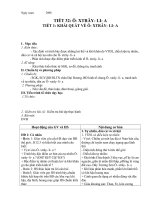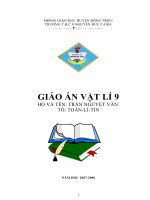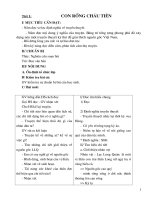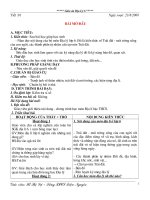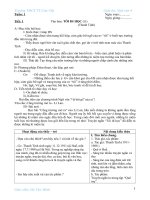giao an tron bo
Bạn đang xem bản rút gọn của tài liệu. Xem và tải ngay bản đầy đủ của tài liệu tại đây (156.99 KB, 10 trang )
Period 1:
INTRODUCTION
I. Objectives: By the end of the lesson, students will be able to:
- get an overview of the English book grade 11 in general: themes, units
- know about tests: oral test, fifteen - minute tests, periodical tests, first term test
- have a sense of responsibility toward learning the subject
II.Preparations:
- Teacher: Handouts, textbook, sub boards and colored chalks.
- Students: Textbook.
III. Anticipated problem and solutions:- The whole lesson: Integrated, mainly
communicative.
IV. Procedures:
Teacher and students’activities
Contents and board display
Warm-up
* Game: Lucky Number
-T divides the whole class into two groups and plays
the game.
- The leader of each group chooses a number for
their own group and does the following requirement
in each question. If the answer is correct, they will
get 10 marks.
- T leads Ss in the lesson.
I. Topics and units:
- Ask Ss to look through the book then tell class how
many units it has.
- Introduce some more information about the topics.
(Including five topics in each term)
- There are 8 periods in each unit. They are Getting
Started, Language, Reading, Speaking, Listening,
Writing, Culture and communication and Looking
Back
II. Tests:
III. Requirements for study preparation
- Each S has books (student book and work book),
CDs and notebook.
- Prepare for the lesson before class.
-Listen to the teacher attentively and take part in the
lesson actively and creatively.
1. Lucky Number
2. How many girls are there in your class?
3. Do you know what your English teacher’s
name is?
4. Lucky Number
5. What do you prepare for this semester?
6. Do you like studying English? Why or
Why not?
7. How do you learn English well?
8. Do you speak English fluently?
1. The generation gap
2. Relationships
3. Becoming independent
4. Caring for those in need
5. Being part of ASEAN
+ 2 reviews
1- Previous lesson check.
2- Fifteen minutes tests (3)
3- Periodical tests (2)
4- First term test
- Take part in the activities that the teacher requires
such as pair work, group work…
- Do all exercises at home, learn new words and
structures
Wrapping up
- Summarize the main points: Getting to know
the content of English 11, tests,….
Homework
- prepare for the next lesson: Unit 1- Getting
started
Wrapping up
Homework
Feedback:
................................................................................................................................................
................................................................................................................................................
Period 2:
Unit 1: THE GENERATION GAP
Lesson 1:
Getting started
I. Objectives : By the end of the lesson, students will be able to:
1. Knowledge
- get to know the topic, vocabulary about the generation gap and family rules, two
grammatical points: should, ought to give opinions and advice, and must and
have to express obligation
2. Skill
- develop listening, speaking, reading skills
3. Attitude and competencies:
- have responsible attitude towards family rules
- understand and actively respond to relevant matters or situations.
- form and improve such competencies as: teamwork, assessment, problem- solving
II. Preparations:
- Teacher: Handouts, textbook, pieces of papers and cassette.
III. Anticipated problem and solutions: Ss forget all knowledge that they have learnt
IV. Procedures:
Teacher’s and students’ activities
Warm-up
.Tell Ss that these differences can be in the choice
of music, clothing, values, lifestyles, ways of
shopping (directly from shopping centers or
online), or communication
Ask Ss questions about the picture: This
is a photo of a big family. Who are the people in
the photo? Is this type of family popular in your
community? Elicit answers from Ss
Activity 1: Listen and read:
Tell Ss that they are going to listen to a
conversation between two friends, Sam and Ann.
Let Ss guess what Sam and Ann are talking about`
- T plays the recording and asks Ss to listen and
pay attention to the text to understand the content.
- Ss listen and read along silently.
Activity 2: Decide whether the sentences are
true, false or not given
- T asks Ss to read the passage again and get
information to do Task 2 in pairs.
- Ask students to compare the answers with a
partner.
- Ask some students to read the answers.
- Checks and gives the correct answers:
Activity 3: Complete the definitions:
- Tell Ss this activity focuses on compound nouns.
• Ask them to complete the definitions, using the
highlighted compound nouns in the
conversation.
• Ask Ss to check answers in pairs.
• Check Ss’ answers.
Contents &Board display
Unit 1: THE GENERATION GAP
Lesson 1:
Getting started
Activity 1: Listen and read:
Activity 2: Decide whether the sentences
are true, false or not given
1. F
2. F
3. T
4. F
5. T
Activity 3: Complete the definitions:
Key
1. A nuclear family
2. Childcare
3. A generation gap
5. A viewpoint
k______________
4. Table manners
6. An extended
family
Activity 4: Find the compound nouns
Ask Ss to read the conversation again to find
seven other compound nouns.
• Allow Ss to use a dictionary to look up the
meanings of the compound nouns.
Tell Ss to compare their answers in pairs / groups.
Then check answers as a class
Activity 5: Find verbs
• Ask Ss to read the conversation again to find
verbs expressing duty, obligation, advice.
Tell Ss to compare their answers in pairs / groups.
Then check answers as a class
Activity 6: Ask and answer
- ask Ss to work in pairs, practice asking and
answering the questions given using the ideas
from the conversation and Ss’ own ideas
Wrapping up
- Summarize the main points: Getting to know
the topic, the vocabulary items related and
modals
Homework : - practice the conversation, asking
and answering questions.
Activity 4: Find the compound nouns
grandparents, grandma, grandpa,
grandmother, hairstyle, housework,
footsteps
Activity 5: Find verbs
Opinion and advice: should, ought to
Duty and obligation: must, have to
Lack of obligation: not have to, not need to
Activity 6: Ask and answer
1. I’m a part of a nuclear/extended family.
2. I learn a lot of skills from my
grandparents.
Feedback:
................................................................................................................................................
................................................................................................................................................
Period 3:
Unit 1: THE GENERATION GAP
Lesson 2: Language
I. Objectives: By the end of the lesson, students will be able to gain:
1. Knowledge
• use words and phrases related to the generation gap and family rules
• identify and pronounce strong and weak forms of words in connected speech
• use modals to give opinions and advice: should, ought to
• use must and have to to express obligation
2. Skill
- listening, reading
3. Attitude and competencies:
- have responsible attitude towards family rules
- understand and actively respond to relevant matters or situations.
- form and improve such competencies as: teamwork, assessment, problem- solving
II. Preparations:
- Teacher: Handouts, textbook, pieces of papers and cassette.
III. Anticipated problem and solutions: Ss forget all knowledge that they have learnt
IV. Procedures:
Teacher’s and students’ activities
Contents &Board display
Unit 1: THE GENERATION GAP
I. Vocabulary: Compound nouns
Lesson 2: Language
Activity 1:
Draw Ss' attention to the four compounds written
as one word: household, hairstyles,
I. Vocabulary: Compound nouns
schoolchildren, footsteps.
Activity 1:
A compound noun is a noun that is made up of
Example:
two or more words.
a 'greenhouse: a place for growing
Each compound noun acts as a single unit and can
plants (compound noun)
be modified by adjectives and other nouns.
a 'green 'house: a house painted green
In compound nouns, the stress usually falls on the
(free word combination)
first word. This helps us to distinguish between
compound nouns and free word combinations.
Key: 1 -g 2-h
3-i
4-f
Activity 2: Complete the questions
- T asks Ss to read the conversation again and get
5-c 6-b
7-a 8-d 9-e
information to do Task 2 individually.
- Ss elicit more chores to add to the list.
Activity 2: Complete the questions
- Ask Ss to compare the answers with a partner.
Key 1. hairstyle / table manners
- Ask some students to read the answers.
2. generation gap
- Feedback
3. nuclear family
II. Pronunciation:
4. junk food
Activity 1: Listen and repeat:
5. schoolchildren
• Play the recording for Ss to listen and repeat.
II. Pronunciation:
• Ask Ss to pay attention to the stressed words
Activity 1: Listen and repeat:
with the stress mark before the stressed
syllable.
• Play the recording again for Ss to listen, pausing
after each sentence. Have Ss work in pairs to
find out the parts of speech of the words which
are stressed in these sentences.
- T plays the recording and asks Ss to listen then
circle the word they hear.
- T asks Ss to work individually and then check
answers as a class
- ask pairs of Ss to role-play the questions and
Activity 2: Listen and check
answers in front of the class
III. Grammar:
Tell Ss that this activity focuses on the use of
should /shouldn't, ought to/ought not to,
must/mustn't, have to/don't have to.
Activity 1:
• Ask Ss to underline the correct words to
complete the sentences, and pay attention to the
meaning of the sentences in order to choose the
right word.
• Have Ss work individually first, then ask them
to compare their answers in pairs.
• Check Ss’ answers.
Activity 2:
Have Ss do this exercise individually. Monitor the
activity and help them, if necessary.
• Check Ss' answers by asking individual Ss to
take turns to read aloud the sentences, and then
write them on the board.
1. strong, weak
2. weak, strong
3. weak, strong
III. Grammar:
Activity 1: Underline the correct words
1. should
2. ought
3. must
4. have to
5. must not
Activity 2: Rewrite the sentences
Key
2.You mustn't use your mobile phone in
the examination room.
3. I don't have to type my essay.
4. You should tell the truth to your
family.
5.Young people must plan their future
career carefully.
Wrapping up
- Summarize the main points: compound
nouns, stressed and unstressed words in
sentences, modal verbs: have to, ought to.
Homework
- complete the exs, do exs in workbook.
Feedback:..............................................................................................................................
................................................................................................................................................
..................
Period 4:
Unit 1: THE GENERATION GAP
Lesson 3:
Reading
I. Objectives :By the end of the lesson, students will be able to gain:
1. Knowledge
information about the generation gap, sources of conflicts between parents and
children
2. Skill
reading for specific information
3. Attitude and competencies:
- have responsible attitude towards family rules
- understand and actively respond to relevant matters or situations.
- form and improve such competencies as: teamwork, assessment, problemsolving
II. Preparations:
- Teacher: Handouts, textbook, pieces of papers and cassette.
III. Anticipated problem and solutions: Ss forget all knowledge that they have learnt
IV. Procedures:
Teacher’s and students’ activities
I.Pre-reading
Activity 1:
- Ask the question ‘Where do you think
family conflicts come from?’
- T asks Ss work in groups, look at the picture and
answer the question.
- T asks Ss to call out the answers to question 1
freely.
• Ask Ss to tick the conflicts (a-g) and then
compare their choices with their partner's.
• Ask some Ss to share their opinions with the
whole class.
* Checking
Ask Ss to skim the text and compare their
predictions in 1.
Check Ss' answers, and ask them to give the clues
from the reading text which helped them to work
out the answers
II.while-reading
Activity 3:
• Ask Ss to match the highlighted words in the
text with the definitions given.
• Tell Ss to go back to the reading text to locate
the highlighted words and study the context
surrounding the words to work out their
meaning. Then match them with the definitions.
• Have Ss work individually, then check their
answers in pairs or groups.
• Check the answers again as a class.
Activity 4:
- Put Ss in groups of three; ask them to read the
questions first to make sure they understand what
information they need in order to answer the
questions. It may help if Ss can understand the key
words in the questions.
Contents &Board display
Unit 1: THE GENERATION GAP
lesson 3:
Reading
I.Pre-reading
Activity 1: Give predictions
Activity 2: Read and check
b, c, d, e, f
II.while-reading
Activity 3: Match the words with definitions
Key
1. afford
2. impose
3. brand name
4. norms
5. conflicts
Activity 4: Answer the questions
1.Because they strongly believe, they know
what is best for their children.
2.They want to be more independent, create
their own opinions, and make their own
- Ask Ss to read the text again, and locate the part
of the text where they can get the answer to each
of the questions before they discuss the answers.
- Check Ss’ answer by inviting a representative
form each group to give the answer to one of the
questions. If the Ss’ answer is incorrect, don’t give
the right one at once, but try to elicit it from other
Ss.
decisions.
3.They are worried because these clothes
may break rules and norms of society, or
distract them from schoolwork.
4.They want their children to spend their
time in a more useful way.
5.No. Some of them try to impose their
choices of university or career on their
children.
III.post-reading
Activity 5: Discuss with a partner
III.post-reading
- have Ss work in pairs and take turns to share
their problems, and give opinions or advice
- ask some Ss to report the results of their
discussion
Wrapping up
- Summarize the main points: sources of
conflicts.
Homework
- practice the conversation, asking and
answering questions.
Feedback:..............................................................................................................................
................................................................................................................................................
..................
Period 5:
Unit 1: THE GENERATION GAP
Lesson 4:
Speaking
I. Objectives: By the end of the lesson, students will be able to gain:
1. Knowledge
-conflicts between teenagers and parents
2. Skill
- speaking: talking about parent-child relationship problems and offering advice on how
to solve them
3. Attitude and competencies:
- have responsible attitude towards family rules
- understand and actively respond to relevant matters or situations.
- form and improve such competencies as teamwork, assessment, problem- solving
II. Preparations: - Teacher: Handouts, textbook, pieces of papers and cassette.
III. Anticipated problem and solutions: Ss forget all knowledge that they have learnt
IV. Procedures:
Teacher’s and students’ activities
Contents &Board display
* Checking
Unit 1: THE GENERATION GAP
- T asks Ss to do the brainstorming
Lesson 4:
Speaking
cookin
g
sweeping
washing
up
Household
chores
Doing the
laundry
Who do the work and the feelings
List three household chores you like and dislike
Discuss the reasons
Give comments and lead in the lesson
1. Activity 1
1. B
2. C
3. A
This activity focuses on conflicts between
teenagers and their parents.
• Ask Ss to read about three situations facing
teenagers, and then match them with the
problems a, b, or c in the box.
• Walk around and help Ss, if necessary.
• Have Ss compare their answers. Check Ss'
answers.
• Ask Ss to further discuss if they have ever
experienced these situations, and how they felt.
They may give advice or express their opinions.
2. Activity 2
.This activity focuses on the ideas and useful
language that Ss can use in 3 when they talk
about their problems with parents.
Key Students ‘answers
• Ask Ss to read the list of things teenagers and
their parents complain about.
• Have them tick the complaints that they hear in
their families.
• Encourage Ss to add some more complaints if
they can.
• Help Ss with any new language they may need
to express their ideas.
focuses on speaking about conflicts between
3. Activity 3
teenagers and parents, and giving opinions and
advice to solve the problems.
• Ask Ss to work in pairs and take turns to tell
their partner what they or their siblings and
their parents often complain about, and then
practise giving advice on how to solve the
problem.
• Encourage Ss to use the structures listed in
Helpful expressions.
• Walk around and help Ss, if necessary.
Ask some pairs to role-play their conversation,
and give feedback
- Ask Ss to consolidate the main contents.
- Give feedback.
Wrapping up:
Wrapping up
- Summarize the main points: parent-child
relationship problems and advice on how to
solve them.
Homework:
Homework
practice the tasks.
- prepare for the next lesson
Feedback:
................................................................................................................................................
................................................................................................................................................
Tron bo xin lien he :
